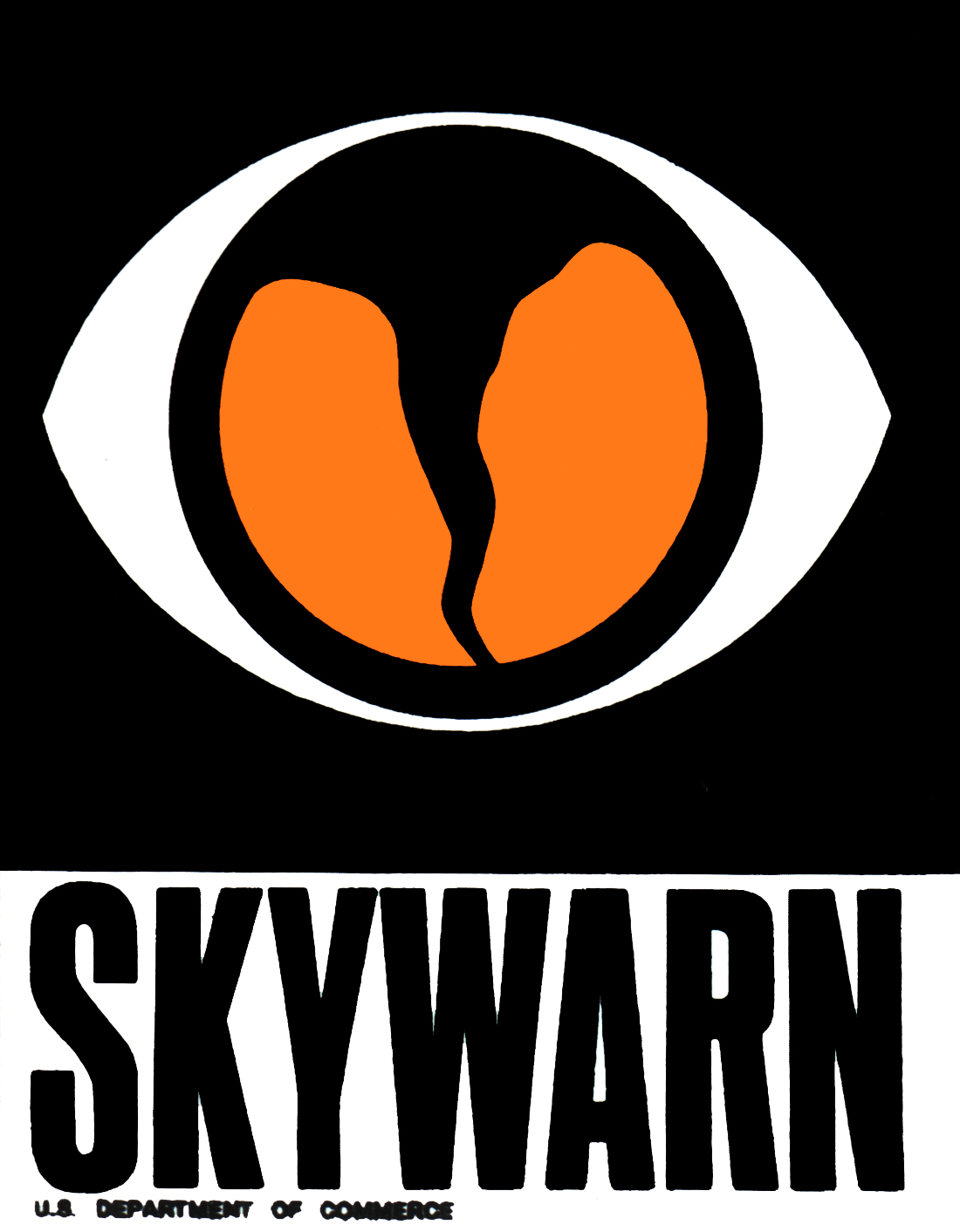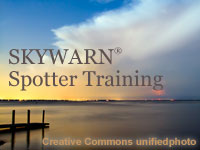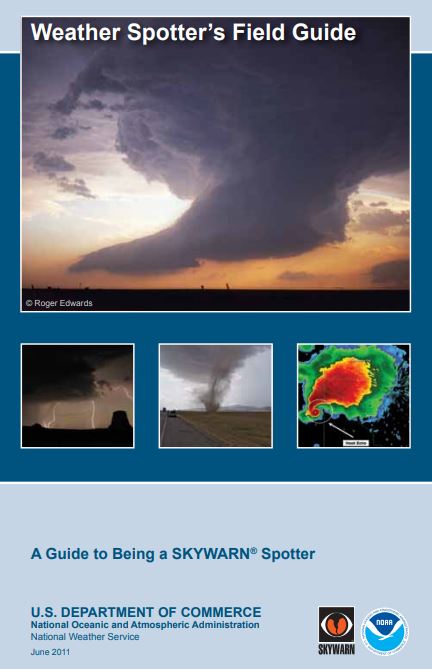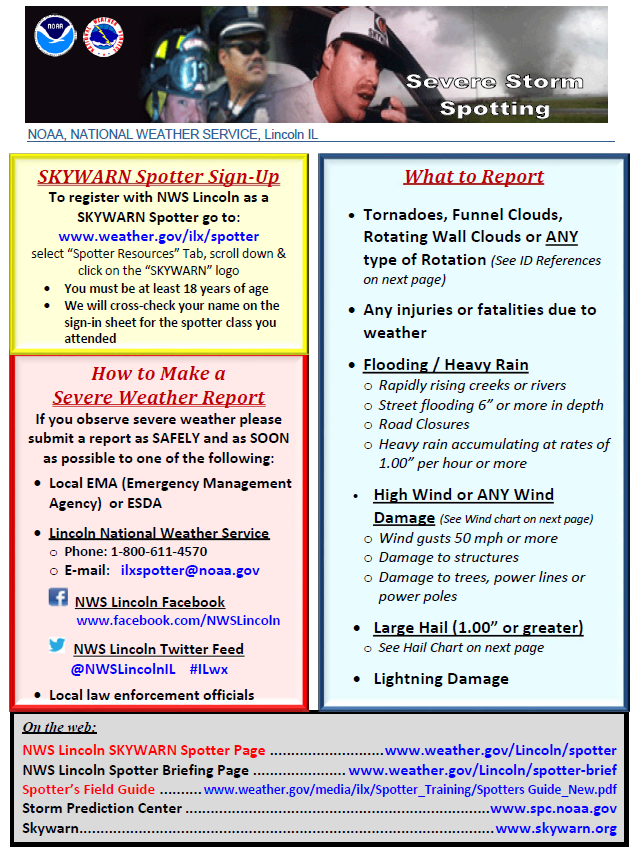Training Schedule
Each Spring, the National Weather Service hosts a series of in-person and virtual spotter talks.
The in-person training covers severe weather hazards including thunderstorms and tornadoes, safety concerns, planning for and anticipating severe thunderstorms, general storm structure and movement, and identification of important storm features. New this year are more interactive portions of the sessions.
You may attend a class offered by any NWS office, regardless of where you live. Links to schedules for nearby offices are available below:
Note: Please click on calendar entry below to view more information about the training session.
1) Online Spotter Training Classes (through UCAR MetEd) 
There is NO COST to take the two classes which make up this training:
"Role of the SKYWARN Spotter" and "SKYWARN Spotter Convective Basics"
All you need is a login account & password on the MetEd web page.
Important Note: You are still HIGHLY encouraged to attend a local spotter training class to learn about local effects and local reporting procedures. The MetEd classes are intended as either a brief introduction to severe storm spotting OR as a refresher for spotters who have attended a class in the last few years.
|
2) NWS Lincoln YouTube videos: We have placed several spotter training topics on our YouTube page. You can either view all the videos at once (approximate run time 26 minutes), or broken down by topic. However, in order to become a certified storm spotter, you either need to attend a class in person, or take the online class above.
3) Additional Resources for Storm Spotters Storm Spotter Guides  NOAA / NASA Sky Watcher Cloud Chart NOAA / NASA Sky Watcher Cloud Chart 
From the Storm Prediction Center: Frequently Asked Questions Facts About Derechos
Sign-up to be a SKYWARN spotter
To register with NWS Lincoln, IL as a SKYWARN Spotter click the SKYWARN logo to the right:
|
|
Important points to remember during severe weather:
What to Report to the National Weather Service: 1. Tornadoes 2. Funnel Clouds, Rotating Wall Clouds or any other rotations 3. Flooding / Heavy Rain a. Rapidly rising creeks, streams or rivers 4. High Wind – around 60 mph and greater a. 40 to 55 mph – small tree branches broken off 5. Damage caused by the Wind a. Size and number of trees / tree limbs blown down. 6. Large Hail (1.00" or greater in diameter)
7. Lightning Damage a. Injuries or fatalities due to a lightning strike |
|
If you observe severe weather in central or southeast Illinois, please make a report as safely & as soon as possible to one of the following locations:
|
|
Q. What is a storm spotter? A. The National Weather Service's (NWS) primary mission is to save lives and protect property through the issuance of warnings for hazardous weather. The WSR-88D Doppler Weather Radar is a great tool for detecting and tracking potentially severe storms and essentially all strong and violent tornadoes. However, NWS meteorologists also depend on real-time reports from trained spotters to know exactly what is occurring on the ground under a storm. The NWS trains people to identify severe storms and tornadoes and report them via organized communications networks (primarily local and county emergency management, law enforcement and amateur radio).
Q. What is the difference between a storm spotter and a storm chaser? A. A storm spotter is volunteer, or paid county or municipal employee who is spotting as a community service. Most spotters work as part of an organized network and are in communication with their community or organization, which is in turn in communication with the NWS. Some spotters are "mobile" spotters in vehicles, but most spot from fixed locations, such as from home, work, or around the community. The purpose of spotting is to alert community officials and the NWS and assist them in warning the public. Schools, hospitals, and other facilities are encouraged to have spotters to alert people in their care of impending severe weather. Storm chasing involves following a developing thunderstorm to view or photograph severe weather phenomena. Chasing may be done for educational purposes or scientific research but is mostly done for personal fulfillment. Q. I want to be a storm chaser. What should I do? A. College of DuPage in Glen Ellen offers storm chasing field trips that are open to students and the public. There are private firms, mostly in the Great Plains, that offer storm chase tours/vacations. Many can be found through an internet search. Q. How do I become a spotter? A. Attend a basic severe weather spotter class. Classes are held throughout the area, they are free and open to the public. The class takes about 2 hours. Most classes are held weekday evenings. The training is generally done from March into early April - before severe weather season. The training consists of a slide and video program which teaches potential spotters about severe storm structure, and how to identify cloud features and other environmental clues to identify severe storms and tornadoes. Communications systems are explained so the spotter knows where to report, and how that information is used by the NWS and local officials. A complete schedule of classes can be found on our website from about February through April. Q. Is there a minimum age requirement to become a spotter? A. Because of the complexity of severe thunderstorm structure and development, and the potential danger involved, spotting is recommended for adults. However, people of all ages attend spotter training classes. Those ages 10 and up are likely to get the most from the class. Youth who are interested in attending a spotter training class are welcome to attend with a parent or other adult.
A. The NWS Lincoln office does not issue spotter ID numbers. Certificates are available on request. Some county emergency management agencies issue IDs and/or certificates. Please check with your local officials. Q. Does the NWS have any training material? A. In the past, the NWS has been able to hand out copies of the Basic Spotters' Field Guide. However, due to limited budgets, the NWS has made the Field Guide available online. You can find it at: https://www.weather.gov/media/ilx/Spotter_Training/SpottersGuideNew.pdf A pair of online spotter training modules are also available as a good introduction to severe storm spotting. These modules are free - all you need is an account on the COMET MetEd web page. For more info or to take the modules go to : MetEd training
For additional questions or more information about spotter training in central or southeast IL, contact NWS Lincoln at 217-732-3089 or email at nws.lincoln@noaa.gov
|